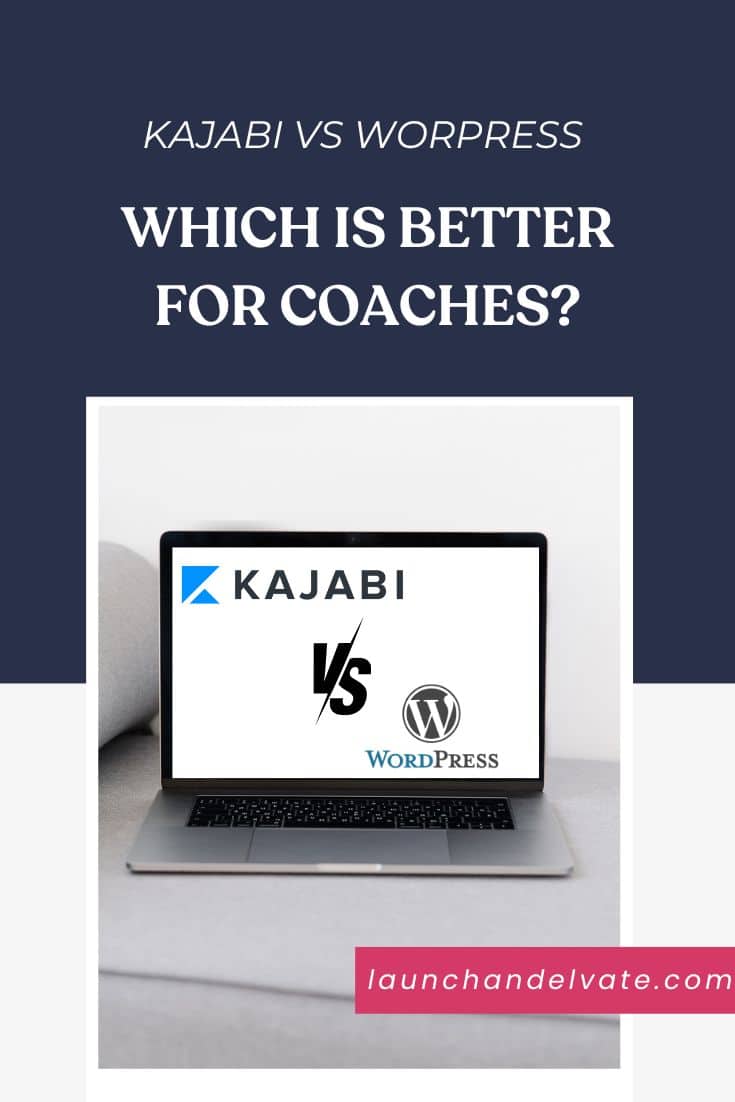Last year, my view on website platforms did a complete 180. Why? Let me share a bit of a story.
I’ve always been Team WordPress. To me, other platforms like Squarespace or Wix just didn’t measure up, especially for SEO. But then, something happened that made me rethink everything.
I have a friend, let’s call them Mary. They ran a WordPress site I helped build – it was perfect for them. However, like many, Mary got swamped and neglected the site’s updates. Eventually, two years later, the site was hacked, and all that effort was lost.
This was a wake-up call. WordPress is great, but it demands constant care, something not everyone can manage.
So, I explored alternatives like Squarespace and Wix again and was surprised. They’ve really upped their game, offering solid SEO and user-friendliness without the constant maintenance headache.
And then came Kajabi…
In 2023, I gave Kajabi a go. Why? A marketing course was all over it, saying it’s your online biz’s best friend. Honestly, with my tech background, I was pretty skeptical. But seeing so many folks dive in made me wonder.
So, what’s the deal with Kajabi? Why is everyone talking about it?
A quick search showed Kajabi affiliates rake in a 30% commission for life. For a basic plan at $149, that’s about $44.7 per signup, every month. 🤯
I had to see for myself. Tested it, then tried to bail. That’s when they threw me a $59 offer for their pricey plan.
So here’s my take, no fluff, no bias, just what I found diving into Kajabi and my comprehensive 7 years of experience with WordPress.
Reasons to Use Kajabi vs. WordPress
Kajabi positions itself as a comprehensive, all-in-one platform designed for entrepreneurs and coaches who prioritize ease of use, integrated tools, and a quick start to market without the complexity of piecing together different services.
Here’s why Kajabi might be the right choice for you:
- Kajabi is an all-in-one platform. It provides website building, course creation, email marketing, and sales funnel capabilities in one place.
- You don’t need to worry about the technical aspects of setting up and managing your website.
- The platform includes marketing tools to help you launch and promote your products effectively such as automation, and landing pages.
Reasons to Use WordPress vs. Kajabi
WordPress, on the other hand, is known for its flexibility and control, making it an excellent choice for those who want a customizable website with the ability to scale and adapt over time.
Here’s why WordPress might be a better fit for your needs:
- You want complete ownership of your site and the freedom to choose your hosting, plugins, and themes.
- Starting with a basic setup can be more cost-effective, with the option to scale up as your business grows. You can read a blog post I wrote a while ago on the actual cost of owning a WordPress website.
- Strong SEO capabilities and the ability to scale with your business needs. Whenever you need a new functionality, you are only a plugin away.
Note: In this blogpost, we refer to WordPress as the wordpress.org (the self-hosted solution). You can read about the differences between WordPress.com and WordPress.org here.
Comparing Kajabi vs. WordPress Side by Side
So here comes the most analytical part that will ultimately help you decide between Kajavi vs WordPress.
Here are some things to consider:
Web Hosting
Web hosting is the service that allows your website to be accessible on the internet. When you build a site, its files need to be stored on a server, which is always connected to the internet. This is what web hosting providers offer.
With Kajabi, hosting is included. This means you don’t have to worry about finding a separate web hosting service. Everything is streamlined, from creating your website to making it live. It simplifies the process, especially for those not technically inclined. However, this ease comes with limitations. If Kajabi’s servers face issues, your site is affected, and there’s little you can do but wait for a resolution from Kajabi’s end.
The day I was testing Kajabi, there was an announcement saying that the servers will be down for an hour for maintenance on that date. 🙄 Now, I don’t know If that is something that happens often or whether it was a one-time thing. But you have such vulnerabilities with systems like Kajabi.
On the flip side, WordPress lets you choose your web hosting provider. This choice means you can select a host based on your specific needs, budget, and the level of control you want. If there’s a problem with your host, you download your website offline and reupload on another host (maybe I am over-simplifying the process, but what I am trying to say is that it’s really possible)
Platform design and UX
When comparing the user experience (UX) for editing websites on Kajabi and WordPress, each platform caters to different types of users with varying degrees of web development skills.
Starting with Kajabi, the platform is designed to be intuitive for users who are not tech-savvy. On the homepage, you can directly choose whether to go to your website, marketing, or products.
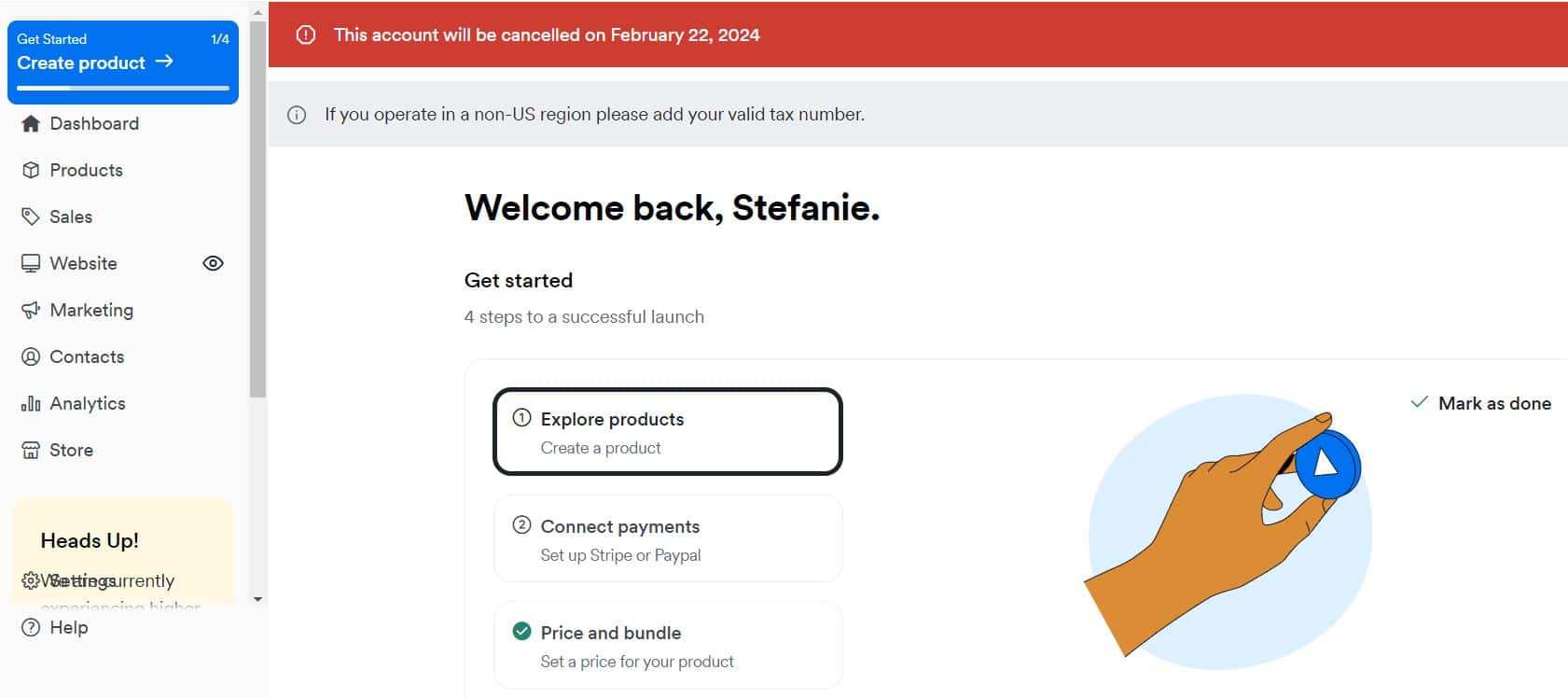
Kajabi offers a range of pre-designed templates that can be customized through a drag-and-drop interface. This simplifies the process of editing your website, allowing you to focus on content creation and design without worrying about the technical details.
Here’s a glimpse into Kajabi’s page editor:

It has some basic widgets and allows you to put your custom branding into the page. But with a little bit of tweaking you can get a basic website to work fine.
On the other hand, WordPress has different levels of customization. You can use themes that work similarly to kajabi and customize them a bit, or you can use tools like Elementor (the one I use) to create custom page design.
My WordPress page builder looks like this:

While WordPress requires a steeper learning curve compared to Kajabi, especially if you dive into custom themes or page builders like Elementor or Divi, it offers unparalleled flexibility. You can practically customize every aspect of your site, from the homepage layout to the footer details.
E-Commerce
When exploring e-commerce functionality, Kajabi and WordPress offer different options tailored to specific needs.
Kajabi’s ecommerce system is structured around “Offers,” and “Ofers”.
Here’s a deeper dive into these concepts:
Products in Kajabi represent the tangible content you create and offer to your audience. This could be anything from online courses, membership sites, to coaching programs. Essentially, Products are the core value propositions you deliver to your customers, the meat of what you’re selling.
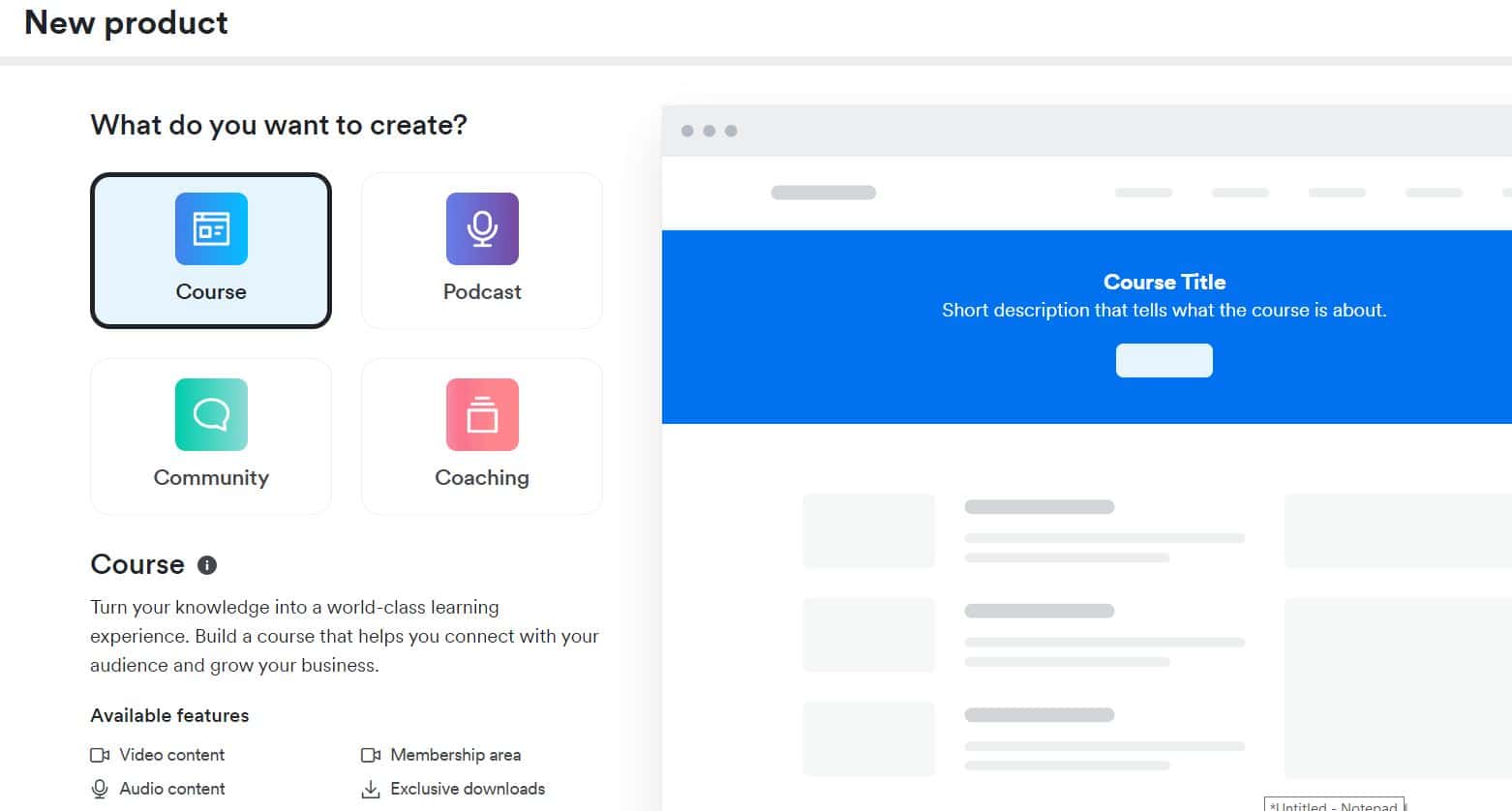
Offers, on the other hand, are your sales and marketing vehicles for these Products. Think of an Offer as a package that includes access to one or more of your Products, along with various pricing options, payment plans, and potential bonuses. Offers are the strategy behind how you present and sell your Products, allowing you to tailor your pricing and bundles to fit different customer needs and preferences.
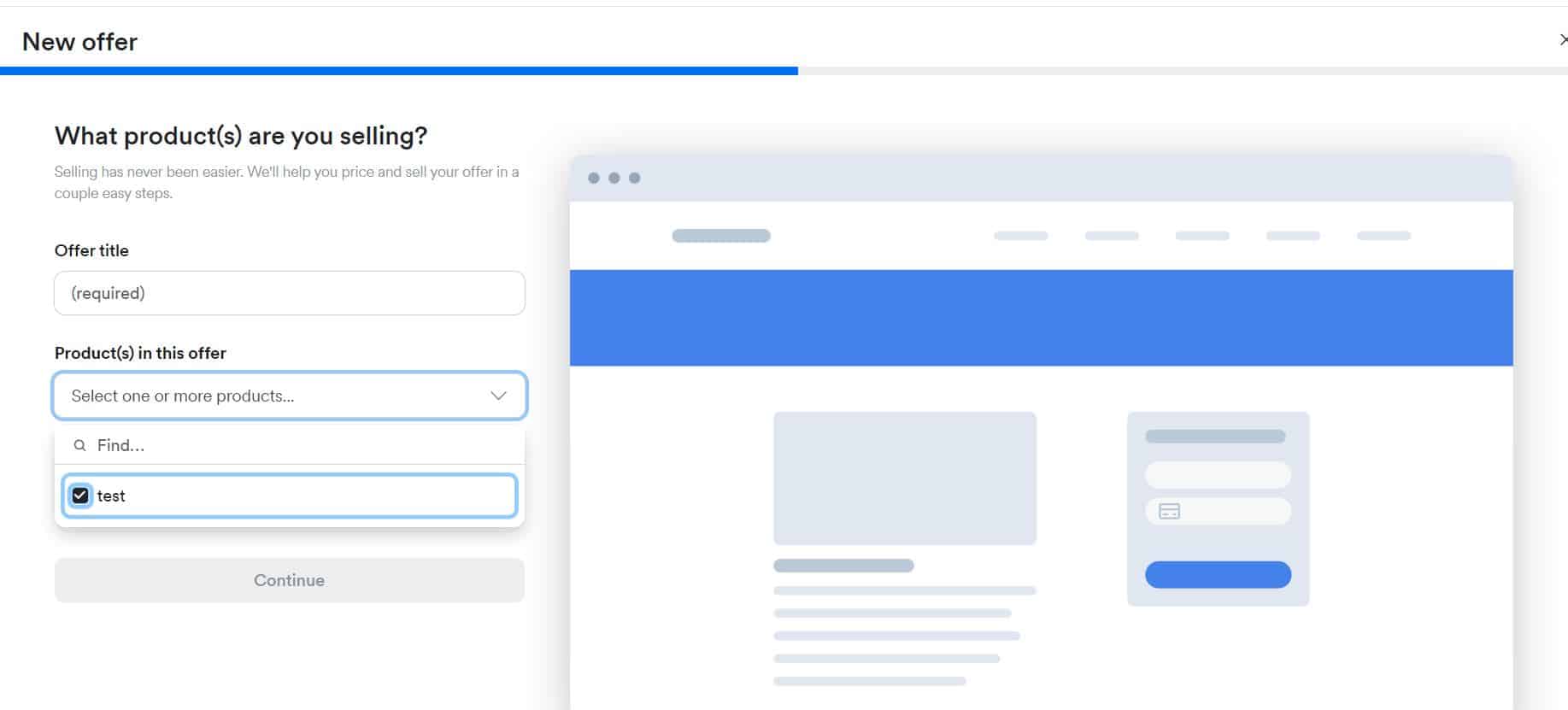
WordPress, when paired with WooCommerce, provides a flexible and powerful solution for selling both digital and physical products. It’s an ideal choice for those seeking extensive customization options and the ability to scale their online store. You can sell multiple products simultaneously as well as use other features such as bundles, and coupons.
With WooCommerce, you have the freedom to integrate various payment gateways, shipping options, and advanced marketing tools. So as your business grows, you can adapt your strategies and include cross-selling and upselling strategies. Although, you would most probably need to hire someone to help you set things up.
Here’s how the setup looks on WordPress:
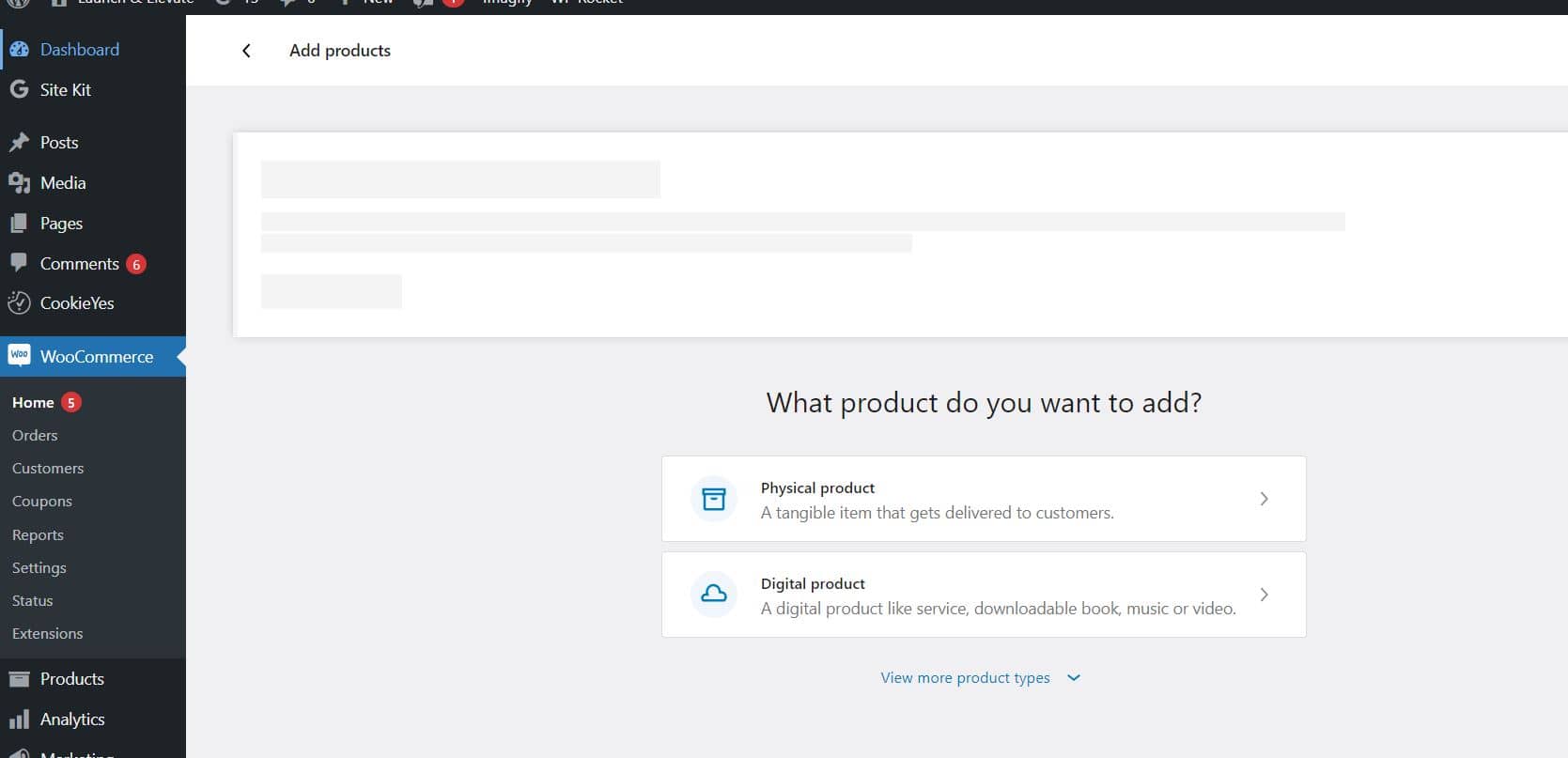
And then you can easily create a product and add a description as it looks below:
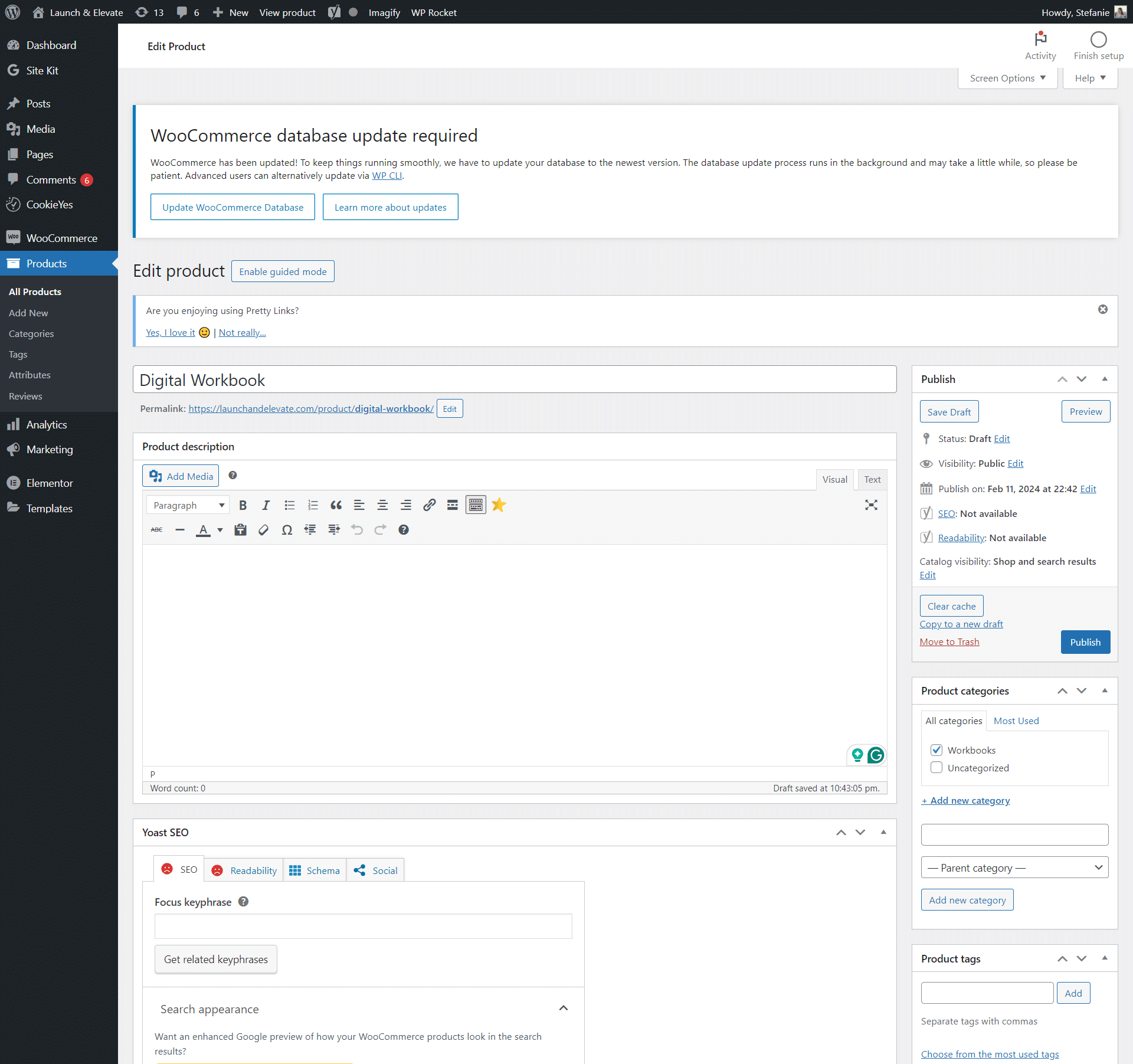
In summary, If your primary focus is on selling digital products with minimal setup and maintenance, Kajabi offers a streamlined, all-in-one solution. However, if you’re looking for a platform that supports a broader range of e-commerce activities and provides extensive customization options, WordPress paired with WooCommerce is a robust choice that can adapt and grow with your business.
Search Engine Optimization (SEO) Capabilities
When it comes to SEO, WordPress and Kajabi offer different levels of control and flexibility to improve your site’s visibility in search engine results. This distinction is crucial for coaches and small business owners aiming to attract more organic traffic and, consequently, drive more sales.
Imagine you’re a life coach specializing in stress management techniques. If someone searches for “stress management coaching,” you’d want your website to appear at the top of Google’s search results. Achieving this requires a solid SEO strategy, focusing on both the technical setup of your site and the optimization of individual pages.
Technical SEO
WordPress stands out for its superior control over technical SEO aspects. Technical SEO involves actions like submitting your site’s sitemap to search engines, crafting a logical site architecture for easy navigation, and optimizing site speed for a better user experience.
WordPress users benefit from the ability to select their hosting provider, which can significantly impact site speed and overall performance. They also have the freedom to access and modify site configuration files, such as the .htaccess file, allowing for custom tweaks to enhance site speed and performance further.
While Kajabi provides a streamlined, user-friendly platform, it lacks the same level of technical SEO customization. Users are somewhat limited in their ability to make the under-the-hood adjustments available in WordPress.
On-Page SEO: Equal capabilities
Both Kajabi and WordPress excel in on-page SEO capabilities, ensuring that each webpage is finely tuned to rank well for relevant searches. This includes the ability to:
- Craft custom title tags and meta descriptions, which appear in search engine results and can influence click-through rates.
- Manage internal linking strategies, ensuring that your site’s pages are interconnected in ways that search engines favor.
- Add descriptive alt text to images, improving accessibility and context for search engines.
- Customize URL slugs, making your URLs more informative and SEO-friendly.
Kajabi simplifies the process for users new to SEO, offering built-in tools for basic on-page optimization without needing additional plugins. WordPress, conversely, provides a more granular level of control through plugins like Yoast SEO, which offers comprehensive guidance and tools for optimizing every aspect of your site’s content and structure.
GDPR Compliance and Cookie Tracking
If your clients are based in Europe or have a global reach, you need to adhere to General Data Regulation (GDPR). GDPR aims to protect user privacy and ensure robust data protection practices across websites and digital platforms
Here’s how platforms like Kajabi and WordPress approach these comprehensive requirements:
Kajabi’s approach to GDPR compliance
Kajabi, as a platform, emphasizes user privacy and data protection. However, it doesn’t provide built-in specific GDPR compliance tools like cookie consent banners directly.
You will need to use third-party services for comprehensive GDPR features such as a cookie banner to generate GDPR-compliant cookie banners. Cookie script, the one suggested by Kajabi, starts with a free plan If you have up to 10 pages or 20k views and the next plan starts at $7 per month.
WordPress – a plugin haven
WordPress shines when it comes to adding cookie consent banners, thanks to huge marketplace.
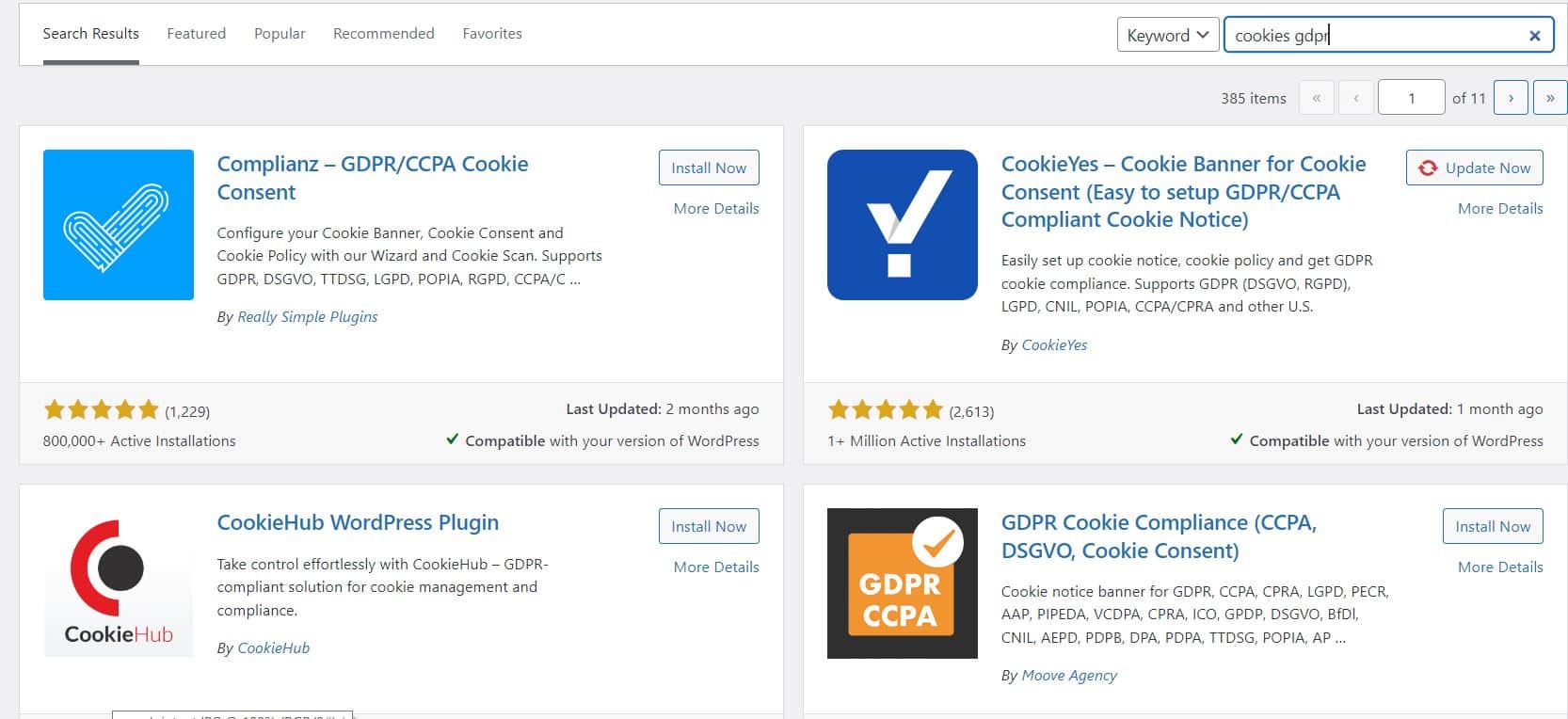
This is the beauty of Open Source, when everyone can contribute with their products. You can find all sorts of plugins in the marketplace.
Email Marketing
As a coach, email marketing is at the forefront of your digital marketing strategies, offering direct communication with your audience. Here’s how Kajabi and WordPress facilitate email marketing efforts:
Kajabi’s integrated system
Kajabi includes an integrated email marketing tool, simplifying the process of connecting with your audience. This built-in feature allows users to create, manage, and send emails directly within the platform, eliminating the need for external email services. This integration is particularly beneficial for users looking to streamline their tools and processes, offering features like email automation, segmentation, and analytics all in one place.
WordPress and external email tools
WordPress, known for its flexibility, does not include a native email marketing tool. Instead, it allows users to integrate with any email marketing service, providing the freedom to choose the tool that best fits their needs. This requires additional steps to integrate and manage external services.
For instance, I use MailerLite for my WordPress sites and that’s the option I recommend for my clients. MailerLite is a powerful yet straightforward email marketing solution that’s free for up to 1,000 subscribers, including automation features. Integrating MailerLite with WordPress is a breeze, there are many ways to connect these two, but I simply put the code of the forms where I want to place them on my website. (Note: I didn’t have to code it myself, I simply copied it from Mailerlite)

Landing Pages
Creating effective landing pages is essential for capturing leads, driving sales, and promoting specific campaigns. Both Kajabi and WordPress offer solutions for building landing pages, but their approaches and flexibility differ.
Kajabi for simplified and streamlined landing pages
Kajabi simplifies the landing page creation process, offering users a selection of optimized templates. These templates are tailored for various goals, such as lead generation, sales, or event promotion, making it easy to start a campaign without worrying about design or functionality.

Kajabi’s editor allows for customization to ensure each landing page aligns with your brand identity. The key advantage here is the platform’s focus on user-friendliness and efficiency, enabling you to deploy landing pages quickly without needing deep technical knowledge.
WordPress for creative freedom
WordPress approaches landing pages with its signature flexibility, allowing for endless customization. Unlike Kajabi, WordPress does not limit you to a set of templates. Any page can be transformed into a landing page, with full control over design elements like headers, footers, and everything in between. This level of customization enables you to tailor your landing pages precisely to your campaign needs and brand style.
However, this freedom comes with the need for some technical savvy, especially when integrating specific functionalities such as payment processing. WordPress users often rely on additional plugins or third-party services to add these capabilities, which can add complexity to the setup process.
The takeaway:
For users prioritizing customization and control over their landing pages, WordPress offers the tools and flexibility required to create anything you can envision. On the other hand, if ease of use and quick deployment are your top concerns, Kajabi’s streamlined process provides a straightforward path to getting your landing pages live, albeit with some creative constraints.
Course Platform
Kajabi for integrated Course Creation
Kajabi shines when it comes to creating and delivering online courses. As an all-in-one platform, it offers integrated tools specifically designed for building, marketing, and selling online courses and memberships. This integration means everything from video hosting to content protection and student engagement tools are built into the platform, ensuring a seamless experience for both course creators and students.
One of Kajabi’s standout features is its ability to create structured courses with a wide range of content types, including videos, quizzes, and downloadable resources. Additionally, Kajabi provides marketing and sales tools, such as email marketing and landing pages, directly integrated into the course creation workflow. This ecosystem facilitates not just the course creation process but also its promotion and sale, all within the same platform.
WordPress for flexibility & advanced customization
WordPress, with its open-source nature, offers a different approach to course creation. Through plugins like LearnDash and MemberPress, WordPress users can transform their sites into full-fledged learning management systems (LMS). Each plugin comes with its own set of features tailored to different aspects of online learning:
- LearnDash specializes in creating and managing online courses, offering advanced features like drip-feed content, quizzes, and certificates. It’s a favorite among educators looking for detailed control over their course structure and student engagement.
- MemberPress combines membership functionalities with LMS capabilities, making it suitable for those who wish to restrict access to courses or offer them as part of a membership model.
Keep in mind that these plugins they require additional setup and potentially some development work.
Course creators using WordPress usually turn to external services like ThriveCart or Thinkific to host courses and leverage specialized e-learning functionalities not available directly within WordPress.
Pricing & cost-effectiveness
So here comes the most interesting part of the blog post, pricing!
Kajabi’s pricing is straight forward. At its lower tier, the plan starts at $149 per month which is $1788 per year If you pay monthly or $1428 If you pay annually.
On the other hand, WordPress costs can vary depending on your needs. Hosting prices might range from $50 to $200. If you want to enhance your site, you could add premium plugins like Elementor Pro for site design at $59 per year, and WP Rocket to improve your site’s performance for another $59. For learning management system (LMS) capabilities, you’re looking at $199 per year for LearnDash or $180 for MemberPress. As for email marketing, MailerLite’s free plan works well for up to 1,000 subscribers. So, you’re looking at around $500 per year for a comprehensive setup. If you want to have maintenance off your shoulders, then expect to pay an additional $50 per month. But if you’re tech-savvy or have the energy to roll up your sleeves and learn the WordPress ropes, you can trim those costs like a pro.
I have written a comprehensive blog post on the real costs of owning a WordPress website and the tech stack I recommend.
Final Verdict: Kajavi vs WordPress
Alright, let’s wrap this up with some straight talk. Both Kajabi and WordPress have their sweet spots, depending on what you’re after for your coaching biz.
Kajabi is like that all-inclusive resort – it’s got everything you need under one roof. You don’t need to worry about piecing together different tools for your website, courses, marketing, and sales. It’s super user-friendly, making it a great pick if tech isn’t your jam. But, remember, all that convenience comes with a price tag and a bit less flexibility.
WordPress, on the flip side, is like building your own custom getaway. It’s incredibly versatile and lets you mix and match hosting, themes, and plugins to get exactly what you want. It’s a powerhouse for SEO and customization. However, it demands more tech savvy and upkeep. If you’re down for a bit of a learning curve and want full control, WordPress is your playground.
So, what’s my take? Drum roll, please… 🥁
If you’re a solo coach or a small outfit starting out, and you want to keep things simple yet effective, Kajabi might be your best bet. It lets you focus more on what you do best – coaching – without getting bogged down by tech.
But if you’re in it for the long haul, ready to learn, and want a platform that adapts and grows with you, WordPress is your arena. Its open-source nature means you’re joining a global community of creators, with the freedom to make your site as unique as your coaching journey.
Remember, there’s no one-size-fits-all answer here. Consider your business size, tech comfort level, budget, and long-term goals. And hey, whatever you choose, you’re taking a step forward in growing your coaching business.


